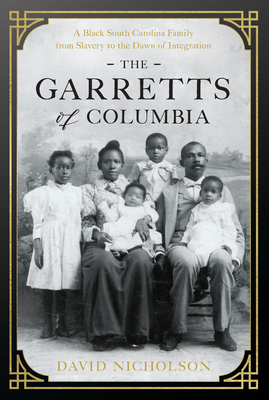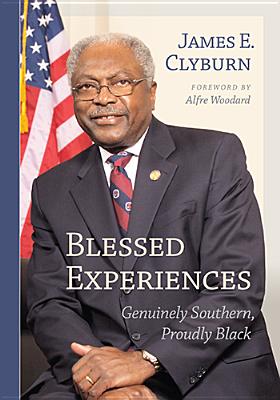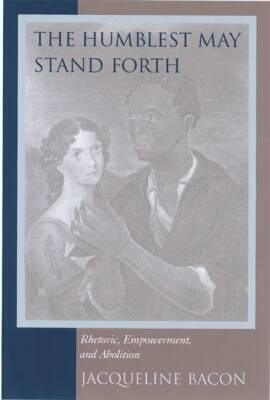8 Books Published by University of South Carolina Press on AALBC — Book Cover Collage
 The Garretts of Columbia: A Black South Carolina Family from Slavery to the Dawn of Integration
The Garretts of Columbia: A Black South Carolina Family from Slavery to the Dawn of Integration
by David NicholsonUniversity of South Carolina Press (Jan 09, 2024)
Read Detailed Book Description
A multigenerational story of hope and resilience, The Garretts of Columbia is an American history of Black struggle, sacrifice, and achievement.
At the heart of David Nicholson’s beautifully written and carefully researched book, The Garretts of Columbia: A Black South Carolina Family from Slavery to the Dawn of Integration, are his great-grandparents, Casper George Garrett and his wife, Anna Maria. Papa, as Garrett was known to his family, was a professor at Allen University, a lawyer, and an editor of three newspapers. Dubbed Black South Carolina’s "most respected disliked man," he was always ready to attack those he believed disloyal to his race. When his quixotic idealism and acerbic editorials resulted in his dismissal from Allen, his wife, who was called Mama, came into her own as the family breadwinner. She was appointed supervisor of rural colored schools, trained teachers, and oversaw the construction of schoolhouses. At 51, this remarkable woman learned to drive, taking to the back roads outside Columbia to supervise classrooms, conduct literacy drives, and instruct rural farm women in the basics of home economics.
Though Papa and Mama came of age in the bleak Jim Crow years after Reconstruction, they believed in the possibility of America. Resolutely supporting their country during the First World War, they sent three of their sons to serve. One son wrote a musical with Langston Hughes during the Harlem Renaissance. Another son became a dentist. A daughter earned a doctorate in French. And the family persevered. But, for all that Papa and Mama did to make Columbia a nurturing place, their sons and daughters joined the Great Migration, scattering north in search of the freedom the South denied them.
The Garretts embraced the hope of America and experienced the melancholy of a family separated by the search for opportunity and belonging. On the basis of decades of research and thousands of family letters—which include Mama’s tart-tongued observations of friends and neighbors—The Garretts of Columbia is family history as American history, rich with pivotal events viewed through the lens of the Garretts’s lives.
 How God Ends Us
How God Ends Us
by DéLana R. A. DameronUniversity of South Carolina Press (Apr 01, 2019)
Read Detailed Book Description
Winner of the South Carolina Poetry Book Prize
Poetic conversations with a God whose omnipotence brings both peace and uncertainty
DéLana R. A. Dameron searches for answers to spiritual quandaries in her first collection of poems, How God Ends Us, selected by Elizabeth Alexander as the fourth annual winner of the South Carolina Poetry Book Prize. Dameron’s poetry forms a lyrical conversation with an ominous and omnipotent deity, one who controls all matters of the living earth, including death and destruction. The poet’s acknowledgement of the breadth of this power under divine jurisdiction moves her by turns to anger, grief, celebration, and even joy. From personal to collective to imagined histories, Dameron’s poems explore essential, perennial questions emblemized by natural disasters, family struggles, racism, and the experiences of travel abroad. Though she reaches for conclusions that cannot be unveiled, her investigations exhibit the creative act of poetry as a source of consolation and resolution.
 The Vain Conversation
The Vain Conversation
by Anthony Grooms
University of South Carolina Press (Mar 01, 2018)
Read Detailed Book Description
Inspired by true events, The Vain Conversation reflects on the 1946 lynching of two black couples in Georgia from the perspectives of three characters—Bertrand Johnson, one of the victims; Noland Jacks, a presumed perpetrator; and Lonnie Henson, a witness to the murders as a ten-year-old boy. Lonnie’s inexplicable feelings of culpability drive him in a search for meaning that takes him around the world, and ultimately back to Georgia, where he must confront Jacks and his own demons, with the hopes that doing so will free him from the grip of the past.
In The Vain Conversation, Anthony Grooms seeks to advance the national dialogue on race relations. With complexity, satire, and sometimes levity, he explores what it means to redeem, as well as to be redeemed, on the issues of America’s race violence and speaks to the broader issues of oppression and violence everywhere.
A foreword is provided by American poet, painter, and novelist Clarence Major. An afterward is written by T. Geronimo Johnson, the bestselling author of Welcome to Braggsville and Hold It ’Til It Hurts.
 Weary Kingdom: Poems
Weary Kingdom: Poems
by DéLana R. A. DameronUniversity of South Carolina Press (May 12, 2017)
Read Detailed Book Description
A Southern-born poet’s journey of reflection and pilgrimage to the streets of Harlem
In this new collection of poems, Weary Kingdom, DéLana R. A. Dameron maps a journey across emotional, spiritual, and geographic lines, from the familiarity of the honeysuckle South to a new world, or a new kingdom—Harlem. Her poems traverse the streets of this Black mecca with a careful eye cast toward the intimacies of the exterior.
Still, as the poems move throughout the built environment, they navigate matters of death, love, love loss, and family against the backdrop of a city that has yet to become home. Indeed what looms over this weary kingdom is a longing for the certainties of a lover’s touch, the summer’s sun, and the comforts of a promised land up North. And as the poet longs, so do readers. Ultimately they grow aware of Utopia’s fragility.
 Walk Me to the Distance (Southern Revivals)
Walk Me to the Distance (Southern Revivals)
by Percival EverettUniversity of South Carolina Press (Oct 18, 2015)
Read Detailed Book Description
Vietnam veteran David Larson can’t go home again. Instead the Georgia native wanders westward into the desolate landscape of Slut’s Hole, Wyoming, and seeks to integrate himself amid a hardscrabble cast of memorable locals. David is taken in by Sixbury, a one-legged widow, sheep farmer, and mother to a nearly adult mentally handicapped son. This rough-hewn family unit is later augmented when David becomes the unwilling guardian to Butch, a Vietnamese girl abandoned at a highway rest stop. A tragic turn of events moves the novel into violent territory that bridges western laconic traditions with southern gothic and interrogates our notions of home, family, duty, and the always uncertain responsibilities of the individual in society.
First published in 1985, Walk Me to the Distance was Percival Everett’s second novel, a hauntingly dark tragicomedy of the modern West, still clinging to a mythical heritage and code of frontier justice. With spare strokes Everett paints a telling landscape of big-sky country, where the mere act of living can be hard, cruel, and heart-stopping. This Southern Revivals edition includes a new introduction by the author and a contextualizing preface from series editor Robert H. Brinkmeyer, director of the University of South Carolina Institute for Southern Studies.
 Blessed Experiences: Genuinely Southern, Proudly Black
Blessed Experiences: Genuinely Southern, Proudly Black
by James E. ClyburnUniversity of South Carolina Press (May 01, 2014)
Read Detailed Book Description
From his humble beginnings in Sumter, South Carolina, to his prominence on the Washington, D.C., political scene as the third highest-ranking Democrat in the House of Representatives, U.S. Congressman James E. Clyburn has led an extraordinary life. In Blessed Experiences, Clyburn tells in his own inspirational words how an African American boy from the Jim Crow-era South was able to beat the odds to achieve great success and become, as President Barack Obama describes him, "one of a handful of people who, when they speak, the entire Congress listens."
Born in 1940 to a civic-minded beautician and a fundamentalist minister, Clyburn began his ascent to leadership at the age of twelve, when he was elected president of his National Association for the Advancement of Colored People (NAACP) youth chapter. He broke barriers through peaceful protests and steadfast beliefs in equality and justice. Of his success Clyburn says he was "blessed with nurturing parents, a supportive family, and loyal friends." But, he added, "my life was not just about knocking down doors and lowering barriers. I spent some time marching in the streets and occupying the inside of South Carolina jails." As a civil rights leader at South Carolina State College, as human affairs commissioner under John C. West and three subsequent governors, and as South Carolina’s first African American congressman since 1897, Clyburn has established a long and impressive record of public leadership and advocacy for human rights, education, historic preservation, and economic development.
Clyburn was elected to Congress in 1992. Serving as copresident of his freshman class, he rose quickly through the ranks and was elected chair of the Congressional Black Caucus in 1999 and House Democratic Caucus vice chair in 2002. Three years later he was unanimously elected chair of the Democratic Caucus. When Democrats regained the House majority in 2006, Clyburn was elected House majority whip. Now as assistant Democratic leader in the 112th Congress, Clyburn, a self-described independent, prides himself on working to overcome barriers and destroy myths without becoming too predictable. "I have worked across party lines to further legislative causes, and on occasion publicly differed with some of my allies in the civil rights community," says Clyburn. "My experiences have not always been pleasant, but I have considered all of them blessings."
Blessed Experiences includes a foreword from Emmy Award-winning actress and the congressman’s longtime friend Alfre Woodard.
 Daufuskie Island: 25th Anniversary Edition
Daufuskie Island: 25th Anniversary Edition
by Jeanne Moutoussamy-AsheUniversity of South Carolina Press (Aug 19, 2009)
Read Detailed Book Description
First published in 1982, Daufuskie Island vividly captured life on a South Carolina Sea Island before the arrival of resort culture through the photographs of Jeanne Moutoussamy-Ashe and words of Alex Haley. Located between Hilton Head and Savannah, Daufuskie Island has since become a plush resort destination. Moutoussamy-Ashe’s photographs document what daily life was like for the last inhabitants to occupy the land prior to the onset of tourist developments.When Moutoussamy-Ashe first came to Daufuskie in 1977, about eighty permanent African American residents lived on the island in fewer than fifty homes. Many of the people still spoke their native Gullah dialect. They had only one store, a two-room school, a nursery, and one active church. This represented all that remained of a once-thriving black society which developed after the original plantation owners left and the land was bought by freed slaves. After the boll weevil caused cotton crop failures and pollution ruined oyster beds, more and more residents sold their land to commercial developers. It became clear that Daufuskie would soon be transformed into a coastal resort like neighboring Hilton Head, changing forever the unique island culture that survived largely unchanged for the preceding half-century. Moustoussamy-Ashe’s photographs show family gatherings, crabbing and fishing, children at play, spiritual life, and the toils of everyday existence. With the utmost respect for her notoriously shy subjects, she captured a powerful vision of their rough-hewn but rewarding life independent from many modern conveniences.Redesigned from cover to cover, the twenty-fifth anniversary edition of Daufuskie Island includes more than fifty previously unpublished photographs from the original contact sheets, a new preface by Deborah Willis, and a new epilogue by Moutoussamy-Ashe.
 The Humblest May Stand Forth: Rhetoric, Empowerment, and Abolition (Studies in Rhetoric/Communication)
The Humblest May Stand Forth: Rhetoric, Empowerment, and Abolition (Studies in Rhetoric/Communication)
by Jacqueline BaconUniversity of South Carolina Press (Mar 01, 2002)
Read Detailed Book Description
Offering an alternative account of the abolitionist movement, The Humblest May Stand Forth analyzes the rhetoric of African Americans and white females involved in the crusade against slavery and examines the particular strategies they chose to advocate despite their positions at the periphery of the movement. Jacqueline Bacon explores how these activists, rather than surrender to a society intent on keeping them quiet, identified and employed rhetorical strategies that would advance their message. Bacon explores the sometimes unconventional methods, organizations, and media they created to fight slavery on their own terms. Drawing on such primary sources as letters, editorials, proslavery and antislavery tracts, and domestic manuals, Bacon probes antebellum notions of race and gender and the ways that these conceptions influenced the abolitionists’ arguments. She suggests that abolitionists marginalized by race and gender developed a diverse, empowering, and theoretically complex array of rhetorical strategies that must be analyzed on their own terms. Examing the words of individual activists, including the well-known figures Frederick Douglass and Angelina Grimke and the less familiar reformers William Whipper, Charles Leuox Remond, Maria Stewart, and Sarah Douglass, Bacon concludes that many marginalized abolitionists achieved a unique kind of agency at the same time they employed, in adapted form, strategies codified by twentieth-century rhetorical analysis.
